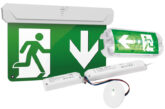
NVC UK explains why ‘self-test’ emergency lighting can help to improve safety while cutting down on maintenance costs.
All contractors will doubtlessly be familiar with emergency lighting products, not least because of the critical role that emergency lighting plays in providing high levels of protection to building occupants at a low unit cost. There are a few realities however, regarding the design responsibility, ongoing maintenance and operation of systems that do merit a refresher.
Huge responsibility
The layout or scheming of an emergency lighting system brings with it huge responsibility so it’s extremely important that whoever produces the design is 100% aware of the legal requirements of the scheme, and recognises that they’re accountable for compliance with the mandatory design standards.
We’d strongly recommend that every contractor reads the Guidance for Electrical Contractors on Emergency Lighting Legislation produced by the ECA – whether they’re designing schemes or just installing them.
Many contractors are installing emergency lighting, based on a scheme provided by an architect, consultant or
another third party. Anyone in this situation, that hasn’t already put in place a disclaimer regarding the design compliance, is taking a risk. Even if a disclaimer is in place, we’d advise that anyone installing emergency lighting is still familiar with the basic elements of the standards.
Maintenance and testing
When the building is handed over, or the installation is complete, there are then a set of responsibilities that pass to the building owner or operator with regard to the maintenance and testing of the emergency lighting system.

The most basic testing regime itself is relatively simple, though ICEL 1008 is more demanding. The basic current standard requires the emergency light fitting to be tested for primary function every month, with a battery duration test (three hours normally) every year.
Our advice for any contractor undertaking an installation handover is to have the test standard written down and, on completion, this is handed to the customer and signed for. Again, this ensures there’s no ambiguity regarding the awareness and responsibility for the ongoing operation and testing of the system.
In terms of system operation, any responsible client that’s committed to operating and maintaining its system
correctly should consider the costs, and counterbalance these against using ‘selftest’ or central monitoring technology.
Note to ‘self’
We’re regularly asked to quote for large volumes of basic products in environments like student accommodation, where simple arithmetic would expose that just performing the basic, mandatory testing would cost thousands of pounds every year. Upgrades to self-test technology has the potential to make the installation much easier to manage and far cheaper to maintain for the building user.
 Any contractor being asked to quote for the installation of large quantities of basic emergency lighting units should challenge the client as to its understanding of the maintenance responsibility and to consider the ongoing costs – there are often better solutions at a relatively low cost that could provide the client with fantastic ROI, and the contractor with an up-sell opportunity. There’s also the opportunity to offer the client a maintenance contract, post-installation.
Any contractor being asked to quote for the installation of large quantities of basic emergency lighting units should challenge the client as to its understanding of the maintenance responsibility and to consider the ongoing costs – there are often better solutions at a relatively low cost that could provide the client with fantastic ROI, and the contractor with an up-sell opportunity. There’s also the opportunity to offer the client a maintenance contract, post-installation.
21st Century product
Fire detection is a “21st Century” product, using addressable technology, self-test, remote monitoring and many more features. As such, there’s no rational reason to justify that emergency lighting – which plays such a significant role in a life safety scenario – should be a poorly maintained, low cost/specification, low priority solution.








